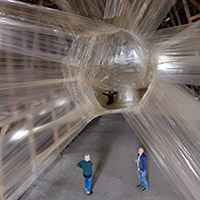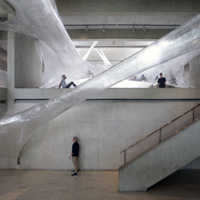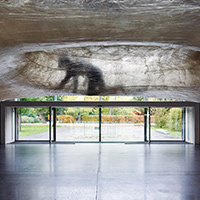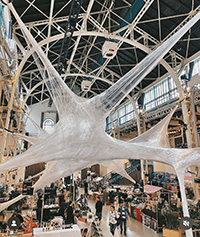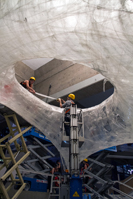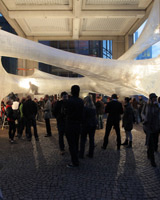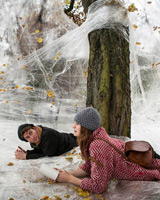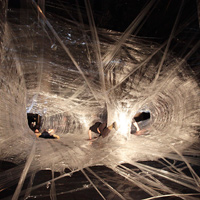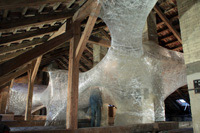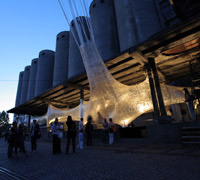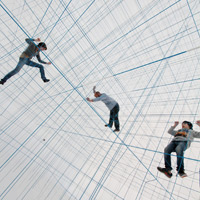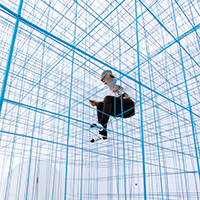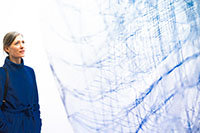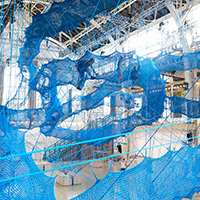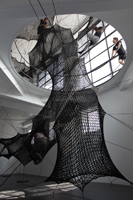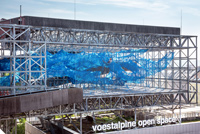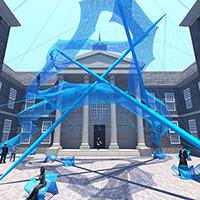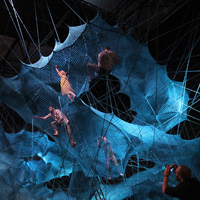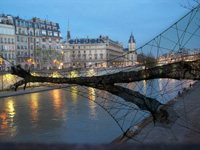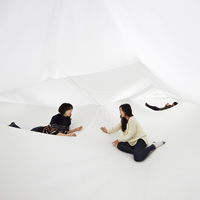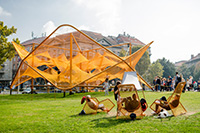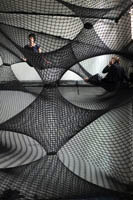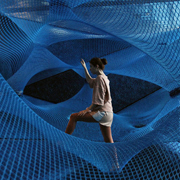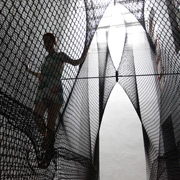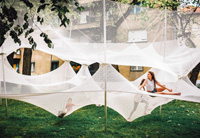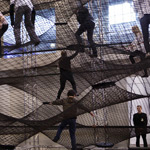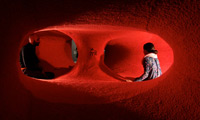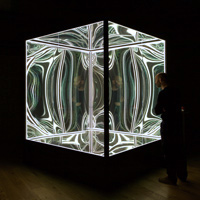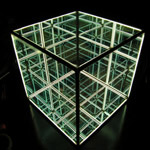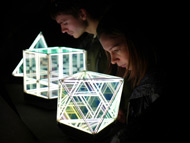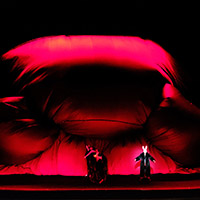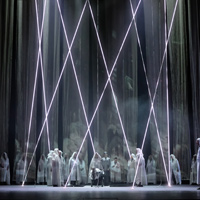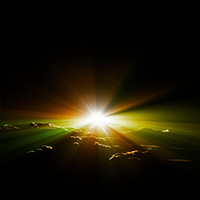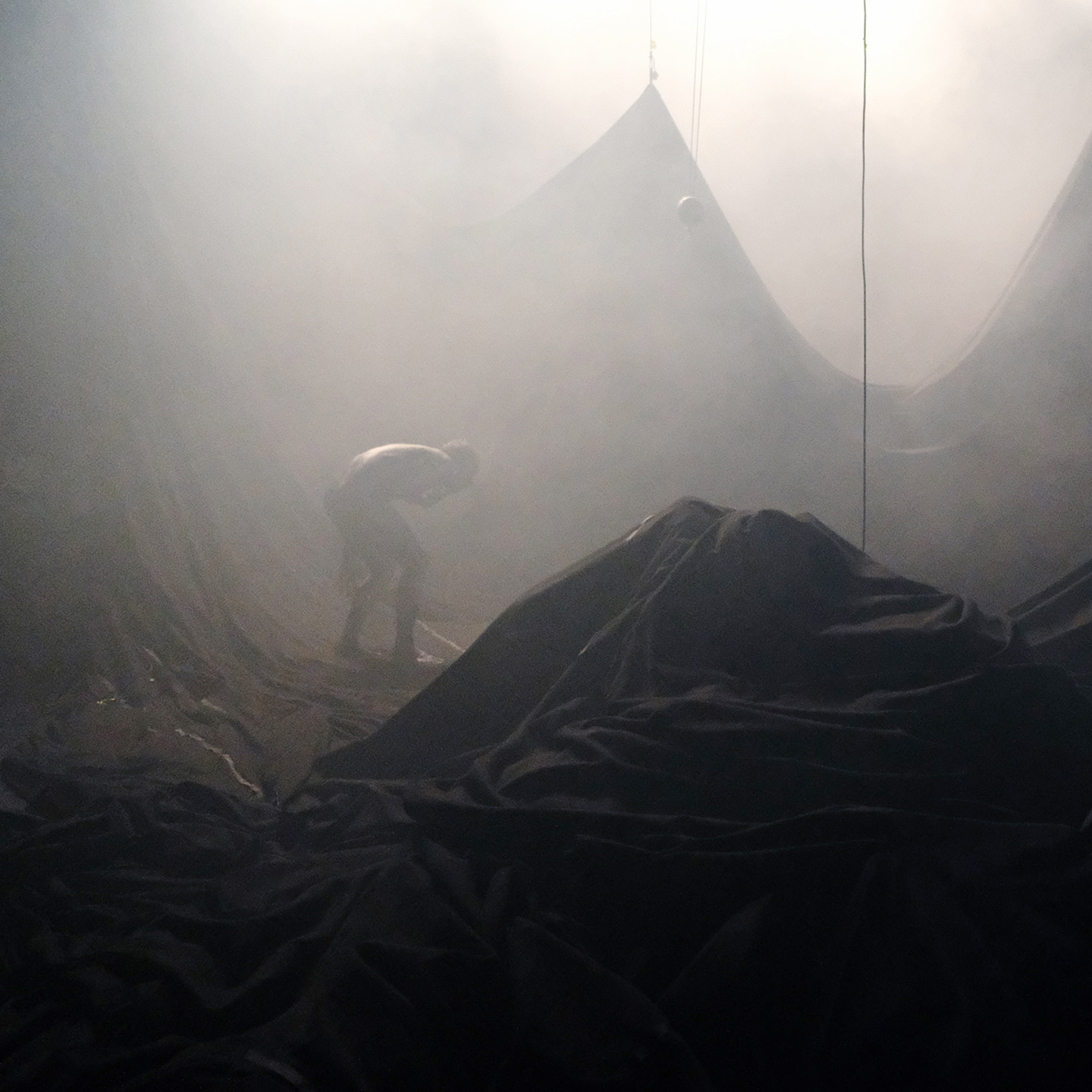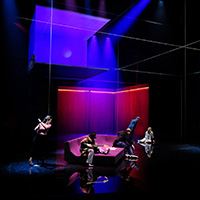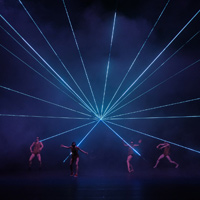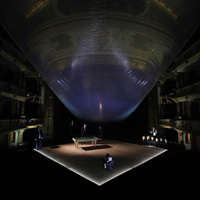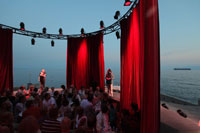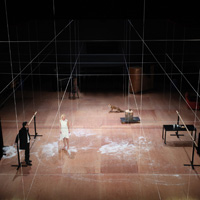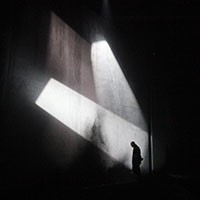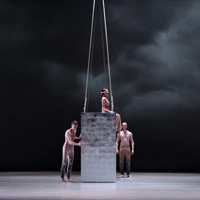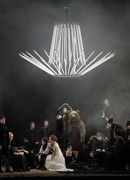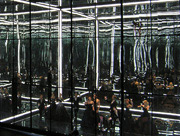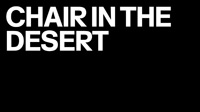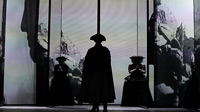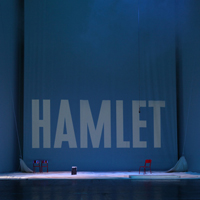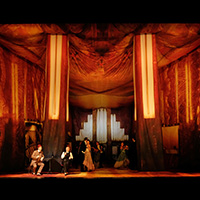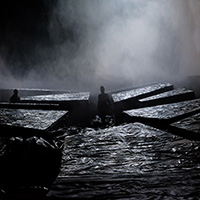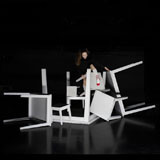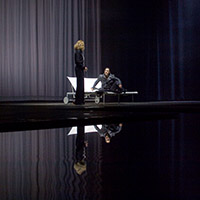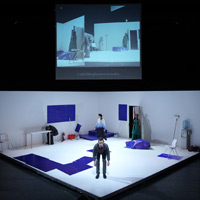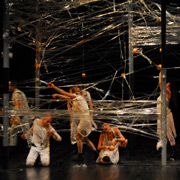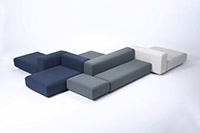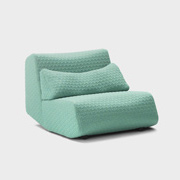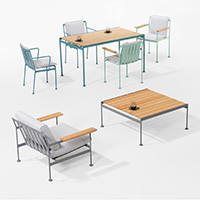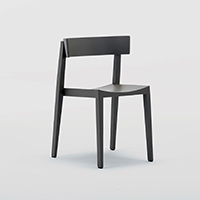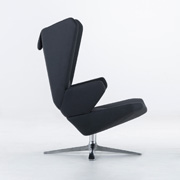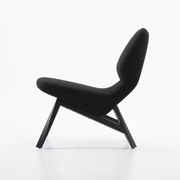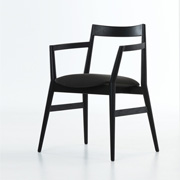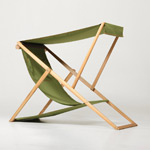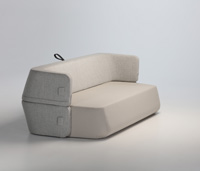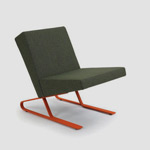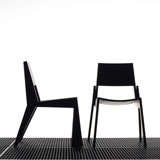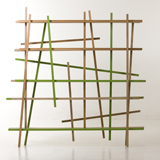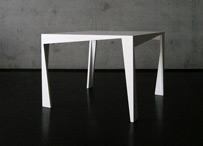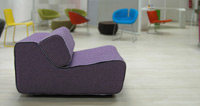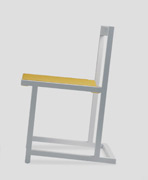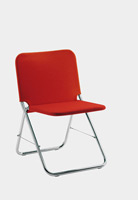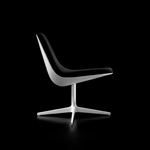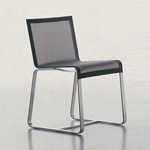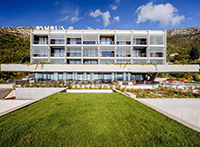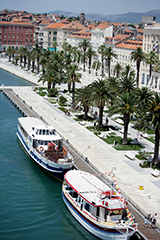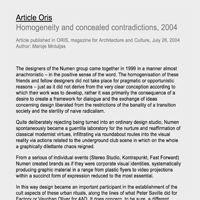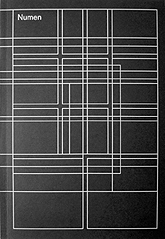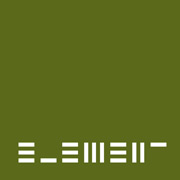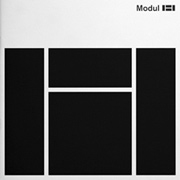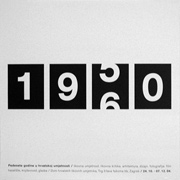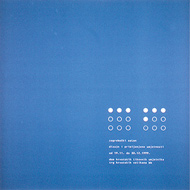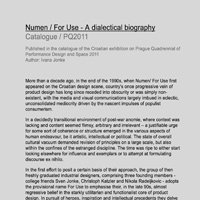Interviewed by Maroje Mrduljaš in Zagreb on 27 August 2016.
Numen / For Use gathered in late 1990s as an informal platform uniting a group of graphic and product designers with a goal of knowledge integration and the development of cooperation. From the mid 2000s Numen / For Use stands for a Croatian-Austrian trio including Sven Jonke, Christoph Katzler and Nikola Radeljković that also gathers a net of contributors and co-authors. Numen / For Use has from its very beginning a rmed its position on the international scene with projects for the world’s most prestigious furniture producers. However, their interests have expanded in the meantime and now include scenography and spatial installations. Keeping in mind the diversity of their activities, it is not easy to summarize Numen / For Use’s work. However, in all of their projects they focus on precision and a empt to master the technical and cultural parameters.
ORIS — In the period from the end of the 1990s to their rst retrospective exhibition held in 2003, Numen / For Use functioned as a collective engaged in graphic and product design. In a way, the model of work was a rudiment of what is now called a co-working space, greatly due to the intensity of togetherness, which I have shared as well. It was the period when we worked and learned at the same time – from prag- matic, technical information to cultural references we never got to know during our education; the American minimalism of Donald Judd or Sol LeWi or Anton Stankovski and others in graphic design. There may have been less unknown facts in product design, but these general references were very interesting and I think that this exchange of knowledge helped us all.
sven jonke — Yes, music too. We started to listen to jazz music; it was a big step. Before that we listened to electronic music, it was also a research... It was not easy to get this music, we did not download it from the Internet, as today.
nikola radeljković — The Croatian Design Exhibition 01, held in the Forum Gallery and organized by the Croatian Designers Society was our first joint project; we worked with graphic designers Toni Uroda and Jelenko Hercog. Other exhibition projects followed, like the 34th Zagreb Salon, the xo- Retrospective of Bruketa&Žinić om, both hosted at the Home of the hdlu (Croatian Association of Artists), and later we did some more commercial realizations, trade exhibition stands like the Module project done for the Exportdrvo company, etc., the whole Stereo Series. The important aspect of this formative phase and the self-education it included was the act of learning about our modernist heritage, which was erased in the national awareness period of the 1990s. The socialist contribution to visual arts was not studied enough and we got to know it during the work on our projects. The Art of the 1950s exhibition, which was curated by Zvonko Maković at the Home of hdlu, was important to me because we were really confronted with our modernist heritage. The cooperation with Zoran Kodrnja, who was involved in most of our projects – architects knew him for his excellent models, was crucial, in terms of the work on our projects, but also in terms of shaping our worldviews. His experience, his intuitive knowledge of all the materials and his wish to share his expertise, were precious to us.
sven jonke — There was not much space for an industrial designer in Croatia at the time, so our collaboration was a kind of a struggle for realization; we used to nd clients ourselves. We o en approached our tasks more ambitiously than we had to; each new project was a new research.
ORIS — The stand for Exportdrvo for the Ambienta Fair is an example of such an expanded task.
sven jonke — It is a good example of taking the initiative. They called us from the Exportdrvo company to do a design of their exhibition stand at the Ambienta Fair. The motto was The future of living and they wanted to exhibit third-rate imported furniture. We offered them a product, a completely designed and branded modular seating system.
ORIS — This product soon became quite successful, but the producer, unfortunately, could not have kept up with the demand. The stand at the Ambienta was an attraction that greatly exceeded the standard; it was organised in a modular raster, monochromatically, I believe that even the uniforms of the hostesses were part of the project. It was a bit forced, but very persuasive and conceptually consistent overlap of the work methods in graphic and product design.
nikola radeljković — Each project is a form of self-realization. A designer, naturally, addresses the needs of the client, but I think that the only way to do something is to do it for your- self as well. You cannot design something if you only consider objective factors, like the demands of ergonomics, construction, etc. You have to have a motive to establish some cri- teria as well. And it is only you who can lay them down. All the projects we worked on were the projects that we would have chosen to do ourselves. We never created something we believed to be good only for the market.
ORIS — The projects of the Bruketa&Žinić om retrospective and the 34th Zagreb Salon are also the examples of a sig- ni cant extension of the assignment since you intervened in the content. At the Bruketa&Žinić exhibition not a single piece was exhibited in its original form; all of their works were reinterpreted and ltered through the prism of Numen. I remember that they were painstakingly sampled using digital photography in an improvised studio, where we worked and lived at the time. Digital camera had just appeared and, in a way, the Bruketa&Žinić exhibition was only a motive for the exhibition that became Numen’s autonomous project. It was expected back then; if you decided to work with Numen / For Use, you would get a total design project. All these projects were an opportunity for a radical experiment and the expan- sion of the task to the limits, even beyond the limits, was crucial.
sven jonke — There was no di erence between living and working. From our current perspective, these situ- ations may have been a bit too designed, too controlled, too tense.
nikola radeljković — The pressure of total design takes you to the area of content where you start to articulate it, which we did in the great exhibitions, like The Art of the 1950s or Avant-garde Tendencies, which we also curated. We lack certain professionals, from copywriters to design man- agers; in developed communities they would simply join the team and do their job. Here, especially at the beginning of the 2000s, we had to do it all by ourselves.
ORIS — Stereo Studio was an interesting project because it was a crossover of di erent areas. The complete project was realised in partnership with a subculture that ts into the scheme of corporate branding; design of a logotype, various graphical applications; posters, invitations, shirts. Even the plastic yers were a hybrid of product design and graphi- cal design, but the act of entering into the space was also important.
sven jonke — dj Felver was the client, but a team member as well. It was a joint, beautiful and synergistic project. The events included some of the rst vjing perfor- mances in Croatia and Jelenko programmed the projections himself. We worked in various spaces, like the Home of hdlu, the former otv House – they all had to be cleaned; it was a complete infrastructural chaos. We had to create atmosphere with very simple lighting; the question was the right amount of light and dark. I would probably do it the same today. Felver chose relevant djs who introduced the new music that was listened to in London and the rest of the world. This minimalist music corresponded very well with our minimalist design, it greatly in uenced our work.
nikola radeljković — I think this was one of those moments of freeing from the limitations of the context. The Croatia of the 1990s was a very closed world, where it was very di cult to nd motive and strength to stand out. This international cooperation, the internation- ally spread movement of smaller and more exclusive variants of techno parties, collaboration with Christoph and interna- tional realizations in the domain of furniture, however, made us communicate with the world. The people who came to play at the parties, Dixon and others, used to sleep at our studio, it was just a way of breaking with the limitations.
ORIS — If you want to realize some of your concepts, it is logical that you look for options, search for the energy in reality that will take you to their realization and tackle the topic head-on and use it to the maximum. The world is not going to come to you, you should go to the world.
nikola radeljković — De nitely. You can make a product out of anything, and I think that the new practices in Croatia clearly show that to us.
ORIS — The Numen / For Use exhibition, organised at the Lexicography Institute in the space of the Music Acad- emy aimed to clearly de ne the methodology of work. The idea was to do the same as Numen did on the projects of Bruketa&Žinić, Zagreb Salon and others – it was to be done on your work and Zlatko Wurzberg played a very important role.
sven jonke — In a way, this exhibition marked the end of the rst era and cooperation with Toni and Jelenko. Our approach was to bare things in order to understand their core and emphasise the idea. We went so far in systematization and reduction that the liberation that followed took some time. Graphical design, however, still has a great in uence on our work. The exhibition was held in 2003 and in 2005 we started with the work in the theatre that a ected us greatly. At the same time, we also designed the Element furniture system for the Intera company, in which you participated as well, where we started to introduce diagonal and free compositions.
ORIS — The projects that followed and went beyond the strictly perceived eld of design included a series of research of re ections and rasters that de ne space. These research projects had several di erent implementations and a way of applying the fascination with a single spatial and formal dis- covery was explored. Numen Light so appears as a prototype of a lighting ing, as well as the project for the Biennale in St. Étienne, as an autonomous project. These were all leaps from the domain of functionality or confrontations with conventions.
sven jonke — Numen Light was developed from the scenography of the play Inferno done in Madrid. The scenography usually follows the text, but this space had no need for the text; in theory, it could have been perceived as an installation. And so we had projects that had no clients.
ORIS — It is interesting to see the way in which the same idea mutates and migrates to completely di erent con- texts and situations. There may have been some absolutistic approach there, though, with the same idea visually applied, sometimes even forced in di erent media. Di erent prob- lems are solved using the same concept.
sven jonke — This is what we have been doing the whole time. We work in so many di erent media and draw inspiration from one another.
nikola radeljković — We do not see an important bound- ary among the media, but we simply see the opportunities and seize them. In the idea of sharing these disciplines, there is the concept of erasing the barrier among the design, architec- ture and scenography. It is all the same to us, one playground within which we test the ideas regarding di erent tasks.
ORIS — Inferno must have been a challenge. All of a sud- den, you found yourselves in a completely new medium and genre. You had to master the laws of the theatre, which may have been easier with Pandur because he insisted on the visual and the scenography was o en the starting point of his work. Architecture within architecture was designed.
sven jonke — Yes, but we discovered that everything can be an illusion in the theatre. The limitations of the material, statics and functionality of architecture and design do not exist there, and this opened a new eld in our work, which is fantasy. There is an enormous technical machinery which is there to service your space, your architecture that does not need to stand, but can oat and should create magic. The possibilities are endless.
nikola radeljković — Actors are not sensitive to functional parameters, they are very ex- ible and can adjust easily. The integral thinking of the whole theatre machine, not just the technical aspects of the scene, but actors, props, the auditorium, etc. is important. It is all a wide playground. If you look at the theatre as a whole, the possibilities are much wider than if you only take the scene and standard methods of scenography into the account. It is strange that only a few designers do scenography when their knowledge and the tools they usually employ are actu- ally pre y adequate.
sven jonke — This methodology of integral design is great because you have to consider many di erent factors in the theatre and have something to connect them all. All arts are connected; costume design, acting, music, architecture...
nikola radeljković — The interpretation of the content must not be literal, but has to bring something new and then everything has to be well-connected so that the visual signature of the play is achieved.
ORIS — If compared to conventional designer tasks, sce- nography is speci c because of the intense and immediate contact with the client, i.e. the director. This relationship is developed during the creative process.
sven jonke — What is surprising is that you enjoy great freedom as a scenographer and you o en start working on the play much before the direc- tor. Directors do a play a er the play and want to be inspired by the space. Because the space is the physical and most mate- rialistic element of the play, it is very de ned, due to nancial and other realistic limitations, and it greatly impacts the play.
nikola radeljković — In most plays, Pandur had the idea of what he wanted from the play. He would already have the de ned visual material, like an inspiration or references, not ref- erences to the theatre, though, but to art history, fashion, etc.
sven jonke — But you could present him with a completely new idea and he would accept it.
nikola radeljković — Yes, like with the Inferno – he came to the meeting not knowing what we would show to him. He did not expect a glass cube, but when he saw our completed model, that was it, it was over.
sven jonke — This cube opened many topics that are con- nected with the installations we are doing now. They resulted from the experience of creating virtual and immersive spaces.
ORIS — The experience of scenography has lead you to spa- tial installations. The variant of the Tape installation was also tested in the theatre format.
nikola radeljković — The use of the adhesive tape in scenography caused certain prob- lems, but the transfer of ideas, content and projects from one area into the other allowed us to realize all of our ideas. With- out any fear of stepping out of our professional eld.
ORIS — The participatory moment of the Tape installation is double; rst when it is being made, since the installation is the result of the collective work, and then in the possibil- ity to enter it; this aspect of becoming a potential space of social interaction is crucial.
sven jonke — It is primarily a structure. It visualises forces very nicely because it is made of an elastic material, which is linear and perfectly shaped by ten- sion. The forces are visualised through the material, through a very thin membrane; the installations are not heavier than 150 kg. The shape is in uenced by the way the installation is made, the process of compression, shrinking. The object is undefined or crude at rst, but then it gets more and more re ned. The curves are made of many lines as a resolution; the more we do, the line is more perfect.
nikola radeljković — In the development of the polygonal element, we started from the minimum to the maximum number of angles and then geome- try suddenly transformed into a curve. The structures are very complex and if they were designed like architecture – with the plan, structural engineer – the preparations would have to be extremely thorough. With the increase or the decrease in the scale of the model, some things are gradually done ad hoc so that, eventually, in a real situation, some oscillations and itera- tions occur and, nally, result in the completed form.
sven jonke — We shape it only by de ning which points will be connected. Later, stronger or weaker stretching determines the parameters, but it is basically created on its own.
ORIS — The relation to the body that is situated in an atypi- cal, di erent and almost primordial space is crucial.
sven jonke — When you see the installation for the rst time, you cannot know how it was made. There is some magic to it because you cannot understand the process of its crea- tion if you do not get informed. We rarely get to be in such an organic space. Elasticity is also very important because, in such installations, you are completely elevated from the oor and so it becomes completely immersive. You even get to feel some discomfort, instability, as if you were oat- ing.
nikola radeljković — It is the feeling of fear and freedom, because everything is so – from all the sides, above and beneath you...
ORIS — There is also another aspect that contributes to the feeling of estrangement and it is the transformation and tak- ing over of the existing spaces. You found yourselves again in the situation of discovering another new, in this case, a gallery context. Have you experienced any new situations and what is it like to enter the global art world?
nikola radeljković — We presented our rst installations in some forms of a designer context – at the DesignMai Festival in Berlin, Vienna Design Week, Mikser festival in Belgrade. Later, we moved to galleries. When we did the exhibition Inside at the Palais de Tokyo, we realized that our work, otherwise iso- lated at some festival events, assumed a completely di er- ent importance. In the context of design, it was an optimistic experiment of new technologies, forms of living, housing, etc. – a brighter view of the future. In the context of the Inside exhibition, where there were so many heavy, introverted works, which tackled isolation, existentialist anxiety and ten- sion, we suddenly started to perceive our work di erently.
sven jonke — It can be interpreted in many di erent ways. In Prague it was part of a dystopian context, with Huxley, Orwell... at the Brave New World exhibition. The installation took on a futuristic element there. And I think that it is crucial that we moved from design to the art scene. A designer is the one who gives the answer and an artist is the one who asks the question. It is the basic di erence between them. We will always be designers because our way of thinking and methodology are that of a designer. But I believe that there are designers who ask questions as well. Art is moving towards design nowadays and design is approaching art.
ORIS — But, basically, the way of use and performances of the installations are always the same, regardless of the con- text.
nikola radeljković — We realized that the instal- lations were actually public scenographies. A passer-by or a visitor of an exhibition becomes a performer when they enter them. The fact is that, in the public space, we are all visitors and actors at the same time, these installations merely emphasise that. The acts of dislocations from the daily life are the key; it is the same cathartic experience we go to the thea- tre for. The installations are very direct and very physical, not only through the visual perception or an image, but through the feeling of the whole body.
ORIS — Can this experience of performativity of space be taken back to product design? Is there a possibility of another migration of context, this time from a gallery to furniture design?
sven jonke — These nets are the extension of furniture, a giant sofa.
nikola radeljković — This was the reason why we moved from duct tape to more durable and quality material. We so started the cooperation with the Regeneracija company on the making of the carpet as a qual- ity inhabitable space, a giant sofa made of 100 % wool that requires a speci c space. We use a post-socialist industry as infrastructure for the production of unique art installations.
sven jonke — We applied the same research in the Amarin hotel, designed by studio up. I would like our installations to become part of the interior and be used in a more permanent and functional form, outside the gallery. It can be a speci c space that provides a special experience, but appropriate for daily use.
ORIS — Radical innovations in the area or living need to break the barrier of habit. The furniture has basically changed very li le over the centuries. Even some radical a empts from the end of the 1960s and the start of the 1970s remained isolated.
nikola radeljković — Currently, there is no way of transforming this research into some form of mass produc- tion or functional architecture. The society is limited, not only by the conservative a itudes of its users, but even more so by the legal acts that de ne the relation of the man with the space. The area of art installation is thus ideal, because there are no rules that govern it. We discovered that this is the grey area where di erent things can be allowed. Our work has been characterised as a work of art, and not as a functional part of the interior in the Amarin Hotel. It is an art installation and can function in that context.
ORIS — A part of the process of design becomes the search- ing for loopholes; this also becomes a part of the project.
nikola radeljković — Regulations should protect us from the reality, but reality is unstable and we can function just ne within it.
ORIS — In light of the cooperation and exchange of knowl- edge and activities in different contexts that we have discussed, the interaction with architects seems most com- mon, although this is not so frequent any longer, at least not in Croatia. The examples of such successful interactions are the projects you worked on with the 3lhd studio – the Waterfront project in Split, which you joined in the post- competition phase and the Hotel Lone in Rovinj, in which you participated from the early stage. I think that the exchange of knowledge was two-way; architecture in uenced the design and vice versa.
nikola radeljković — In the Lone project, we got the possibility of large-scale realizations and we, naturally, could not have said that we were interested only in objects. We started a dialogue through which we thought of many solutions. In the hotel, everything starts from the room, which is the biggest investment. But some decisions that greatly impacted the exterior in Lone resulted from the study of the interior, like the mirror applications that were extended to the exterior, the terraces, the black parapet on all inner lines – these were some of the solutions for the interior that were copied in the exterior.
ORIS — The Lone project coincides with the return of prod- uct design in Croatia. It also served for the testing of some products that were produced later, not in Croatia, however. Lone also raised the level of standard and drew a ention to the importance of collaborative projects that are supported by the client.
sven jonke — We designed up to 80 % of the furniture ourselves; some was just for the Lone. The idea was that of a Gesamtkunstwerk and it is felt in the whole impres- sion – that it is about the synergy of the authors, not the com- pilation.
nikola radeljković — Architectural projects are an excellent testing area where some projects can be applied for the rst time, but this is not our discovery. When a large project is being done, a new product is designed just for the project and through this rst use, the price of the product is covered. The furniture industry, architecture and construction are thus connected.
sven jonke — It was more common in former Yugoslavia.
ORIS — At the Kvadra company, now called Prostoria, the preconditions of the furniture industry that includes rst- rate design are nally met. They have all that de nes a seri- ous company; promotion and placement of the product on the market, etc.
sven jonke — We have tried to approach industry production in Croatia in many ways, but it was never successful. One of the crucial elements of the success of Prostoria is that we, as well as the other designers, are given absolute freedom. It is a big thing that Tomislav Knezović, the founder of Prostoria, believes in us. We only do industrial design with them now.
ORIS — How much is your cooperation with Prostoria be er if compared to that with distinguished international com- panies? There, you are just one in the line, you wait for your product to be developed, they have their marketing plan and decide on the right moment to launch a certain product.
nikola radeljković — I think that only now we are start- ing with the serious industrial design. In popular brands, they simply have no time or space to work with you, not just the management, but the technicians as well. In Prostoria, we have the methodology of work that Charles and Ray Eames had, and others in the 1950s – they are willing to modify, develop and constantly work on the product. The development process does not end when the product is launched – they use the feedback from the market, do error and defect analyses and return the product to the factory to be xed. New possibilities are considered and this whole process is then used as the base for the development of new products. Their way of work may be old-fashioned, but is very high quality.

